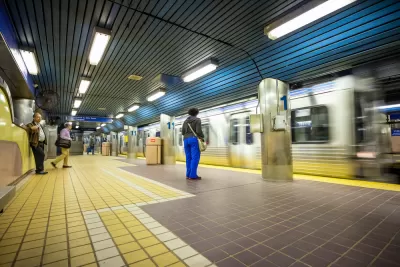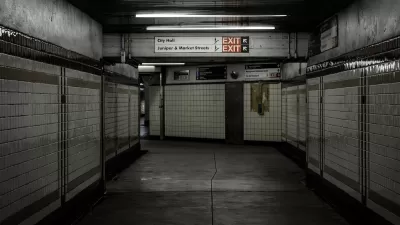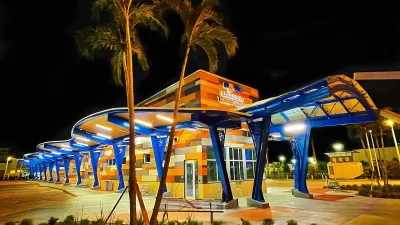As ridership dropped during the pandemic, Philadelphia's transit agency started locking station doors to keep unhoused people from using the tunnels as shelter. Now, riders are becoming trapped inside.

Describing the experience of one rider with a disability that forces her to minimize walking, Jake Blumgart outlines how new security measures on Philadelphia's SEPTA trains are trapping riders who now have to walk much longer distances to accessible exits or are unable to enter or exit stations altogether. "The agency confirmed at least 10 riders have been trapped in the tunnels after walking through a one-way turnstile, only to find doors to the street barred and locked."
To explain: "Center City’s rail stations are connected to a vast, and confusing, concourse system that runs beneath the heart of downtown Philadelphia. As commuter and tourist traffic vanished with the pandemic in 2020, people living on the streets increasingly used the tunnels as shelter. SEPTA closed access points and cordoned off huge sectors of the underground."
Now, writes Blumgart, "SEPTA is spending millions to contract with social service organizations to help address the issue, but the new maze of mysteriously locked doors, gated exits, and other unfriendly impediments are making the system less accessible for everyone." SEPTA has pledged to reopen some areas and provide more clear signs explaining closures. Yet "Several riders interviewed for this article found them confusing, if less inscrutable than their absence was last year."
Transit systems in other cities are experiencing similar stresses, with varied responses. "In a December 2020 survey of 115 transit agencies, half said they had experienced a surge in homeless ridership." With ridership still far below pre-pandemic levels and budgets strained, the agencies are struggling to implement new programs to offer social services and make riders feel safe.
FULL STORY: Riders are getting trapped in rail stations after SEPTA ‘hardens’ the system to keep out unhoused people

Maui's Vacation Rental Debate Turns Ugly
Verbal attacks, misinformation campaigns and fistfights plague a high-stakes debate to convert thousands of vacation rentals into long-term housing.

Planetizen Federal Action Tracker
A weekly monitor of how Trump’s orders and actions are impacting planners and planning in America.

In Urban Planning, AI Prompting Could be the New Design Thinking
Creativity has long been key to great urban design. What if we see AI as our new creative partner?

King County Supportive Housing Program Offers Hope for Unhoused Residents
The county is taking a ‘Housing First’ approach that prioritizes getting people into housing, then offering wraparound supportive services.

Researchers Use AI to Get Clearer Picture of US Housing
Analysts are using artificial intelligence to supercharge their research by allowing them to comb through data faster. Though these AI tools can be error prone, they save time and housing researchers are optimistic about the future.

Making Shared Micromobility More Inclusive
Cities and shared mobility system operators can do more to include people with disabilities in planning and operations, per a new report.
Urban Design for Planners 1: Software Tools
This six-course series explores essential urban design concepts using open source software and equips planners with the tools they need to participate fully in the urban design process.
Planning for Universal Design
Learn the tools for implementing Universal Design in planning regulations.
planning NEXT
Appalachian Highlands Housing Partners
Mpact (founded as Rail~Volution)
City of Camden Redevelopment Agency
City of Astoria
City of Portland
City of Laramie




























